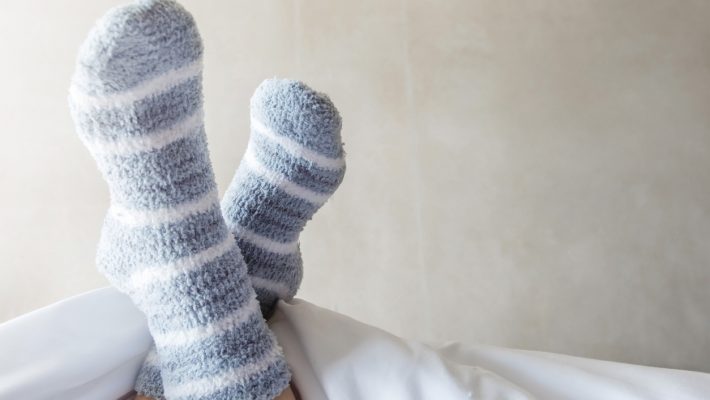
The Case for Sleeping with Socks On
Can’t sleep, cold feet
Cold feet might be the reason behind your restless nights. When your feet are cold, they constrict the blood vessels and cause less blood to circulate. According to the National Sleep Foundation, warming your feet before you go to bed helps give your brain a clear sleep signal that its bedtime.
And the easiest way to warm your feet? Socks. Wearing socks in bed is the safest way to keep your feet warm overnight. Other methods such as rice socks, a hot water bottle, or a heating blanket may cause you to overheat or get burned.
Sleep isn’t the only benefit of wearing socks at night. Read on to learn how this new habit could change your life.
Why you should sleep with socks on
- Other than helping your body stay warm, wearing socks at night also has extra benefits:
- Prevent hot flashes: Some women find wearing socks helpful for cooling their core body temperature.
- Improve cracked heels: Wearing cotton socks after you moisturize can help keep your heels from drying out.
- Decrease chance of Raynaud’s attack: Raynaud’s disease is when affected areas of the skin, usually the toes and fingers, lose circulation and start to throb or swell. Wearing socks at night can help prevent an attack by keeping your feet warm and blood circulating.
What socks to wear
Socks made of natural soft fibers such as merino wool or cashmere are best. They usually cost more than cotton or artificial fiber socks, but they are well worth the extra money. Make sure the socks you choose are not tight-fitting, which might constrict circulation and hinder proper warming of your feet.
To enhance circulation
- Give your feet a pre-bedtime massage.
- Add a natural circulatory booster such as capsaicin cream to your massage oil or favourite moisturizer. This helps amp up the blood flow even more.
- Warm your socks by sitting on them or using a hairdryer before putting them on.
The one downside to wearing socks while you sleep is overheating. If you do overheat or feel too hot, kick off your socks or leave your feet outside your blanket.
What about compression socks?
Avoid wearing compression socks at night unless prescribed by your doctor. Even though they’re known to improve circulation by increasing blood flow, they aren’t meant to be worn to bed. Compression socks move blood flow away from your feet and may block blood flow when you’re lying down.
How to make your own rice socks
If a hot bath or foot bath is not available, or if you like having a longer-lasting heat source in your bed, you can try using rice socks. You will need:
- sturdy socks
- rice
- rubber bands
Steps:
- Pour 3 cups of rice into each sock.
- Close the sock with a sturdy rubber band.
- Heat up the rice socks in the microwave oven for 1 to 2 minutes.
- Slip them under the blankets next to your chilly feet.
Things to avoid
- Do not heat the rice socks in the oven as that can become a fire hazard.
- Do not use if you have reduced skin sensitivity as you could get a burn.
- Do not use on children or older adults unless you can supervise to prevent any burn accidents.
Other ways to keep your feet warm
Warm foot baths were found to help relieve insomnia and fatigue in people undergoing chemotherapy. Taking a hot bath or just a foot bathTrusted Source before bed also increases body temperature and can help you fall asleep easier. Warms baths are also a natural solution, readily available, and don’t involve any medication.
If your feet are constantly cold, your circulation may be at fault. Check with your doctor if you have serious circulatory problems or any chronic diseases such as diabetes.
Can children and infants sleep with socks on?
For infants and children, it’s best to avoid electric blankets or heat socks. The safest way to encourage sleep is a nice warm bath as part of their bedtime routine, followed by dressing their feet in pre-warmed socks.
If you choose to use a hot water bottle, make sure the temperature is safe and place a soft cotton blanket around it so there is no direct contact between the bottle and skin.
Always check your baby or child for signs of:
- overheating
- sweating
- red flushed cheeks
- crying and fidgeting
If you notice these signs, remove additional layers of clothing or blankets right away.
The bottom line
Warming up your feet before going to bed can shorten the amount of time needed to relax and doze off. This in turn can increase the quality of your sleep. Make sure the socks you wear are soft, comfortable, and not too bulky. Consult a doctor if you have circulatory problems that cause pain and cold feet, or if you often have cold feet even when its warm.

